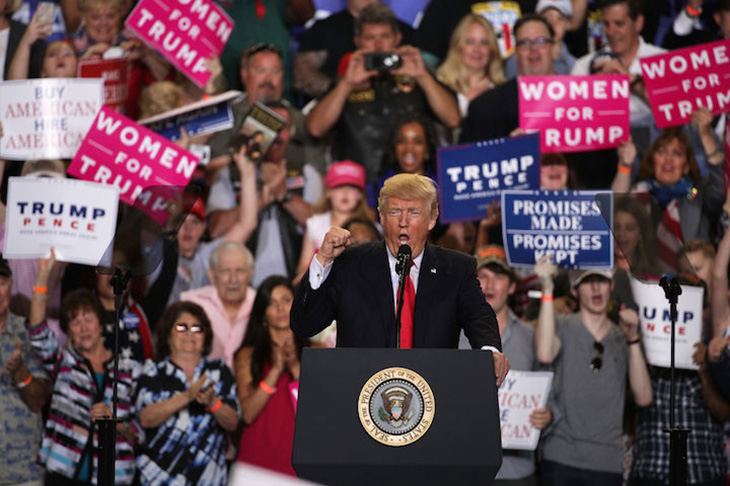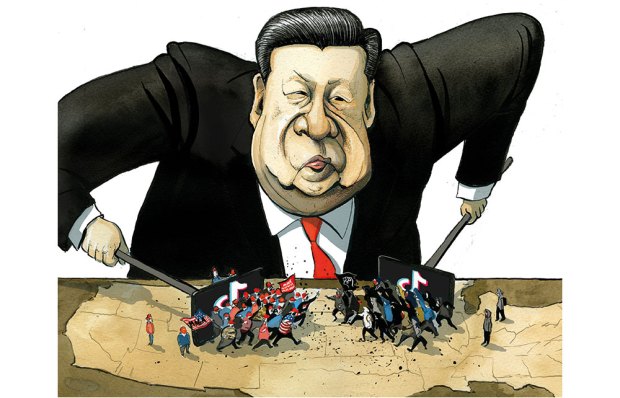New York
As the malevolence and incoherence of the Trump administration continue to amaze, Democrats are taking heart from the popular revulsion against the Mad Hatter of Mar-a-Lago. The media class is chattering excitedly about anti-Trump momentum after special Congress elections in conservative Kansas and Georgia resulted in a narrow Republican victory in the former and a run-off in the latter. Last week, Paul Kane of the Washington Post cited this as proof ‘that Democrats have galvanised the anti-Trump activism of the past three months into votes at the ballot box’. Last Monday, the New York Times went even further by publishing a piece on the already crowded field of Democratic presidential challengers for the 2020 election, a group of politicians the paper said were ‘uniformly emboldened by Trump’s perceived vulnerability’.
I’m as horrified by Trump as the next liberal, but I think the establishment media have got it wrong again, just like last November when they said Hillary Clinton couldn’t lose. What they can’t see is that the Democrats, far from presenting a unified opposition, are more divided than ever, and this intra-party divisiveness augurs ominously in favour of a second Trump administration.
Evidence is everywhere that the Democrats in opposition are already proving to be a failure. Much has been written about the non-accomplishments and confusion of Trump’s first 100 days in office, but little is said about the utter blurriness of the rival position — the lack of a clear platform to reclaim blue-collar voters with white skin who, in just enough numbers, lifted Trump to victory in the crucial states of Wisconsin, Michigan and Pennsylvania.
What do the Democrats agree on? Only the hope that Trump will collapse of his own ignorance, absurdity and corruption, which is not really a winning proposition, since his eccentricities and ill-gotten billions seemed to work well during the election. They, meanwhile, continue to disagree violently on the most important issues that got Trump elected — outsourcing of jobs to countries with cheap labour, and illegal immigration of foreigners willing to work cheap — while continuing to preach cultural liberalism and tolerance of ‘diversity’. I noticed this at a launch for an anti-Trump anthology to which I had contributed. The bookstore was packed with anguished anti-Trump voters in Manhattan’s ultra-liberal Upper West Side, but I soon clashed with the other speaker, a lesbian rabbi named Sharon Kleinbaum. She challenged my argument that Trump’s attacks on the Bill Clinton-sponsored North American Free Trade Agreement had killed Hillary.
Parroting the latest New York Times-Washington Post line, Kleinbaum blamed the decline of the industrial Midwest on ‘automation’ as opposed to the access to cheap labour facilitated by Nafta and Bill Clinton’s other big trade deal, Permanent Normal Trade Relations with China. In case I hadn’t heard the rabbi, her partner Randi Weingarten, president of the powerful American Federation of Teachers and a dyed-in-the-wool Clintonite, approached me at the signing and barked: ‘You’re completely wrong about Nafta. It’s automation.’
Automation is a canard designed to turn debate away from trade and the disaffected working class in favour of more convenient excuses for Hillary’s defeat, like Russian government hacking, sexism or racism. Besides the fact that robots and machines have to be maintained by people, hundreds of thousands of the jobs that went to Mexico and China were not automated (in one maquiladora I visited, labour was so cheap that the company switched to hand assembling staplers formerly made by machine in New York). Nafta and PNTR, though called ‘free trade’ agreements, are mainly investment deals (designed to protect against expropriation) that encourage US companies to exploit not only the huddled masses of China and Mexico, but also those countries’ lack of environmental rules. Many white Trump supporters voted for Obama believing he would do something about Nafta and PNTR.
Thus the Democrats remain divided between a reformist faction, led by the anti-Nafta senators Bernie Sanders and Elizabeth Warren, and the Wall Street-funded, pro-global-isation Clinton-Obama faction. The fissure is so great that even supposed victories against Trump — such as the withdrawal of a Republican-sponsored bill to eviscerate Obamacare — can’t paper over it. Although House Minority Leader Nancy Pelosi congratulated herself, it was obvious that opposition from hard-right, anti-government purists within the Republican party, not from unified Democrats, had stopped the bill.
Trump is broadly correct that Obamacare is a mess that may eventually ‘explode’ — and honest Democrats know it. An imitation of Mitt Romney’s healthcare plan in Massachusetts (conceived by the right-wing Heritage Foundation), the Affordable Care Act is a hodgepodge of subsidies for private insurance policies sold through barely competitive state insurance exchanges that is neither universal nor low-cost, though it has helped millions of previously uninsured people. The Sanders-Warren faction wants universal healthcare like that in the UK, Canada or France, and so do most Americans — when it’s described as Medicare for everyone.
But the Clinton-Obama regulars are busy blunting Sanders and Warren. The façade of party unity was shattered in February when state party officials were forced to choose between Keith Ellison, the black Muslim congressman backed by Sanders for the chairmanship of the Democratic National Committee, and Thomas Perez, the former labor secretary supported by Obama and his surrogates. When Perez won the second ballot, he immediately named Ellison as his deputy, and the media made believe all was well. This pretence at unity was nonsense: as a faithful apparatchik, Perez supported the Obama-negotiated Trans-Pacific Partnership trade deal, which Sanders, Ellison, Trump and virtually all US unions opposed. Last week, Trump said he’d agreed ‘not to terminate Nafta at this time’; he reportedly intended to announce a unilateral withdrawal but lost his nerve. Still, he’s considerably to the populist left of the Clinton Democrats on trade.
Meanwhile, Hillary Clinton is starting to make fundraising speeches; in April she addressed audiences including the feminist Annie’s List in Houston and the LGBT Community Center in New York. It won’t happen right away, but a draft Hillary (or her surrogate) for 2020 campaign can’t be very far behind. It’s Trump’s best hope for re-election.
Got something to add? Join the discussion and comment below.
Get 10 issues for just $10
Subscribe to The Spectator Australia today for the next 10 magazine issues, plus full online access, for just $10.
You might disagree with half of it, but you’ll enjoy reading all of it. Try your first month for free, then just $2 a week for the remainder of your first year.














Comments
Don't miss out
Join the conversation with other Spectator Australia readers. Subscribe to leave a comment.
SUBSCRIBEAlready a subscriber? Log in